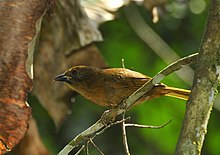Habia rubica
| Red-crowned ant tanager | |
|---|---|
 |
|
| A male red-crowned ant tanager at Bertioga, São Paulo State, Brazil | |
 |
|
| A female red-crowned ant tanager at Miracatu, São Paulo State, Brazil | |
| Scientific classification | |
| Kingdom: | Animalia |
| Phylum: | Chordata |
| Class: | Aves |
| Order: | Passeriformes |
| Family: | Cardinalidae (see text) |
| Genus: | Habia |
| Species: | H. rubica |
| Binomial name | |
|
Habia rubica (Vieillot, 1817) |
|
The red-crowned ant tanager (Habia rubica) is a medium-sized passerine bird from tropical America. The genus Habia was long placed with the tanagers (Thraupidae), but it is actually closer to the cardinals (Cardinalidae). Consequently, it can be argued that referring to the members of this genus as ant-tanagers is misleading, but no other common name has gained usage.
Red-crowned ant tanagers are 18 cm (7.1 in) long and weigh 34 g (1.2 oz) (male) or 31 g (1.1 oz) (female). Adult males are dull reddish brown with a brighter red throat and breast. The black-bordered scarlet crown stripe is raised when the bird is excited. The female is yellowish brown with a yellow throat and yellow-buff crown stripe.
The Red-crowned ant tanager is a shy but noisy bird. Its call is a rattle followed by a musical pee-pee-pee.
This bird is a resident breeder from Mexico south to Paraguay and northern Argentina, and on Trinidad. Common in its wide range, it is not considered threatened by the IUCN.
It preferentially occurs in the middle stratum of the forest as well as undergrowth rich in ferns, shrubs and herbs. These birds are found in pairs or family groups. They eat mainly arthropods, but berries are also taken. In Central America and Trinidad they frequently attend army ant columns, and in the lowland forests of southeastern Brazil they may be a nuclear species of understory mixed-species feeding flocks – though further uphill, e.g. in the Serra de Paranapiacaba, they seem to join such flocks only rarely and prefer to follow the ants on their own. They also follow South American coatis (Nasua nasua) on their feeding excursions, namely in the dry season. In both cases, they are commensales, snatching invertebrate prey startled by the ants or coatis.
...
Wikipedia

